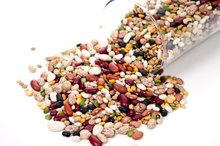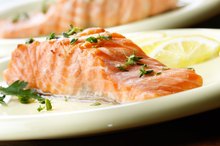List of Fibrous Carbohydrates
While all carbohydrates provide fuel for the body, some carbohydrates provide a higher quality fuel source. Because they are high in fiber, fibrous carbohydrates typically take longer to digest than more refined carbohydrates. Because they take longer to digest, fibrous carbohydrates can help you feel full longer, helping to contribute to weight loss. According to John Abdo, Ph.D., eating a diet high in fibrous carbohydrates can irritate sensitive stomachs. Abdo suggests steaming fibrous carbohydrates until they are soft.
Vegetables
Nearly all vegetables are fibrous carbohydrates. Every 100g serving of peas has a fiber content of 8.3g. Lima beans have 6g of fiber per 100g serving. Carrots, squash, spinach, green, yellow and red peppers and mushrooms are all fibrous carbohydrates. Because fibrous vegetables are usually low in calories in addition to high in fiber, you can usually eat these items without having to keep track of how much you eat. In her book, "Eating Between the Lines," Kimberly Lord Stewart describes fiber as "nature's Brillo pad, scrubbing your intestines clean as it works its way though your body."
- Nearly all vegetables are fibrous carbohydrates.
- Because fibrous vegetables are usually low in calories in addition to high in fiber, you can usually eat these items without having to keep track of how much you eat.
Legumes
List of Roughage Foods
Learn More
Legumes are fibrous sources of carbohydrates. A 100g serving of navy beans has 10.4g of fiber. The same quantity of black beans has have 8.7g of fiber. A serving of lentils offers 7.8g of fiber. A serving of chickpeas provides 7.6 g of fiber. About 1/4 cup of peanuts have about 3g of fiber and walnuts have 2g. Kidney beans, lima beans, white beans and soybeans are also fibrous.
- Legumes are fibrous sources of carbohydrates.
- A 100g serving of navy beans has 10.4g of fiber.
Whole Grains
An easy way to increase your consumption of fibrous carbohydrates is to gradually increase your consumption of whole grains. A slice of whole-wheat bread has 2g of fiber, while white bread has just 1g. A cup of whole-wheat spaghetti has 4g of fiber. A cup of Raisin Bran cereal has 6g of fiber. The same quantity of Fiber One cereal has 14g.
- An easy way to increase your consumption of fibrous carbohydrates is to gradually increase your consumption of whole grains.
- A cup of whole-wheat spaghetti has 4g of fiber.
Related Articles
References
- "Make Your Body a Fat Burning Machine"; John Abdo, Ph.D., H.M.D.; 2002
- Dietary Fiber Food: High Fiber Food
- Tufts School of Medicine: Fiber Content
- "Eating Between the Lines"; Kimberly Lord Stewart; 2007
- Centers for Disease Control and Prevention. (n.d.). Nutrition for Everyone: Basics: Carbohydrates.
- American Academy of Family Physicians. (n.d.). Fiber: How to Increase the Amount in Your Diet.
- Doyle, C. (November 2011). Jump on the "Bran Wagon" for Better Health. American Cancer Society Expert Voices.
- United States Department of Agriculture. (n.d.). Health and Nutrition Benefits of Grain Food Groups.
Writer Bio
Sydney Hornby specializes in metabolic disease and reproductive endocrinology. He is a graduate of Claremont McKenna College and Drexel University College of Medicine in Philadelphia, where he earned his M.D., and has worked for several years in academic medical research. Writing for publication since 1995, Hornby has had articles featured in "Medical Care," "Preventive Medicine" and "Medical Decision Making."









